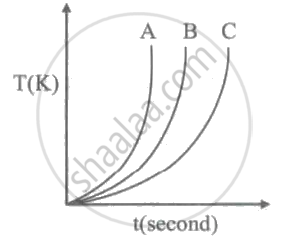Advertisements
Advertisements
प्रश्न
To study energy exchange between hot and cold objects, the system of both objects is isolated from the environment by keeping them inside ______.
पर्याय
a heat-resistant box
a rectangular box
Hope’s apparatus
None of these
उत्तर
To study energy exchange between hot and cold objects, the system of both objects is isolated from the environment by keeping them inside a heat resistant box.
APPEARS IN
संबंधित प्रश्न
State two factors upon which the heat absorbed by a body depends
Heat energy is supplied at a constant rate to 100g of ice at 0 °C. The ice is converted into water at 0° C in 2 minutes. How much time will be required to raise the temperature of water from 0 °C to 20 °C? [Given: sp. heat capacity of water = 4.2 J g-1 °C-1, sp. latent heat of ice = 336 J g-1].
An electric heater of power 600 W raises the temperature of 4.0 kg of a liquid from 10.0℃ to 15.0℃ in100 s. Calculate:
- the heat capacity of 4.0 kg of liquid,
- the specific heat capacity of the liquid.
Explain the term boiling ?
Ice cream appears colder to the mouth than water at 0℃. Give reason.
How much heat energy is released when 5.0 g of water at 20℃ changes into ice at 0℃? Take specific heat capacity of water = 4.2 J g-1 K-1, Specific latent heat of fusion of ice = 336 J g-1.
Name the radiations for which the green house gases are opaque ?
State the effect of enhancement of green house effect.
How will you prove experimentally that different substances have different specific heat capacities?
650 J of heat is required to raise the temp. of 0.25 kg of lead from 15°C to 35°C. Calculate the Sp. heat capacity of lead.
Is it possible to condense the water formed, back to ice by adding ice at 0°C. Explain with reason.
Discuss how high specific heat capacity of water helps in formation of land and sea breeze.
Consider the statement given below and choose the correct option.
Assertion: Radiation is a form of heat transfer which takes place only in vacuum.
Reason: The thermal energy is transferred from one part of a substance to another part without the actual movement of the atoms or molecules.
Express the change in internal energy in terms of molar specific heat capacity.
Which of the following substances (A, B and C) has the highest specific beat?

An office room contains about 4000 moles of air. The change in the internal energy of this much air when it is cooled from 34° C to 19° C at a constant pressure of 1.0 atm is (Use `gamma_"air"` = 1.4 and Universal gas constant = 8.314 J / mol K) ____________.
On supplying 100 µC of charge to a conductor, its potential rises by 5 V then capacity of the conductor is ______.
A block of ice of mass 120 g at temperature 0°C is put in 300 gm of water at 25°C. The xg of ice melts as the temperature of the water reaches 0°C. The value of x is ______.
[Use: Specific heat capacity of water = 4200 Jkg-1K-1, Latent heat of ice = 3.5 × 105 Jkg-1]
